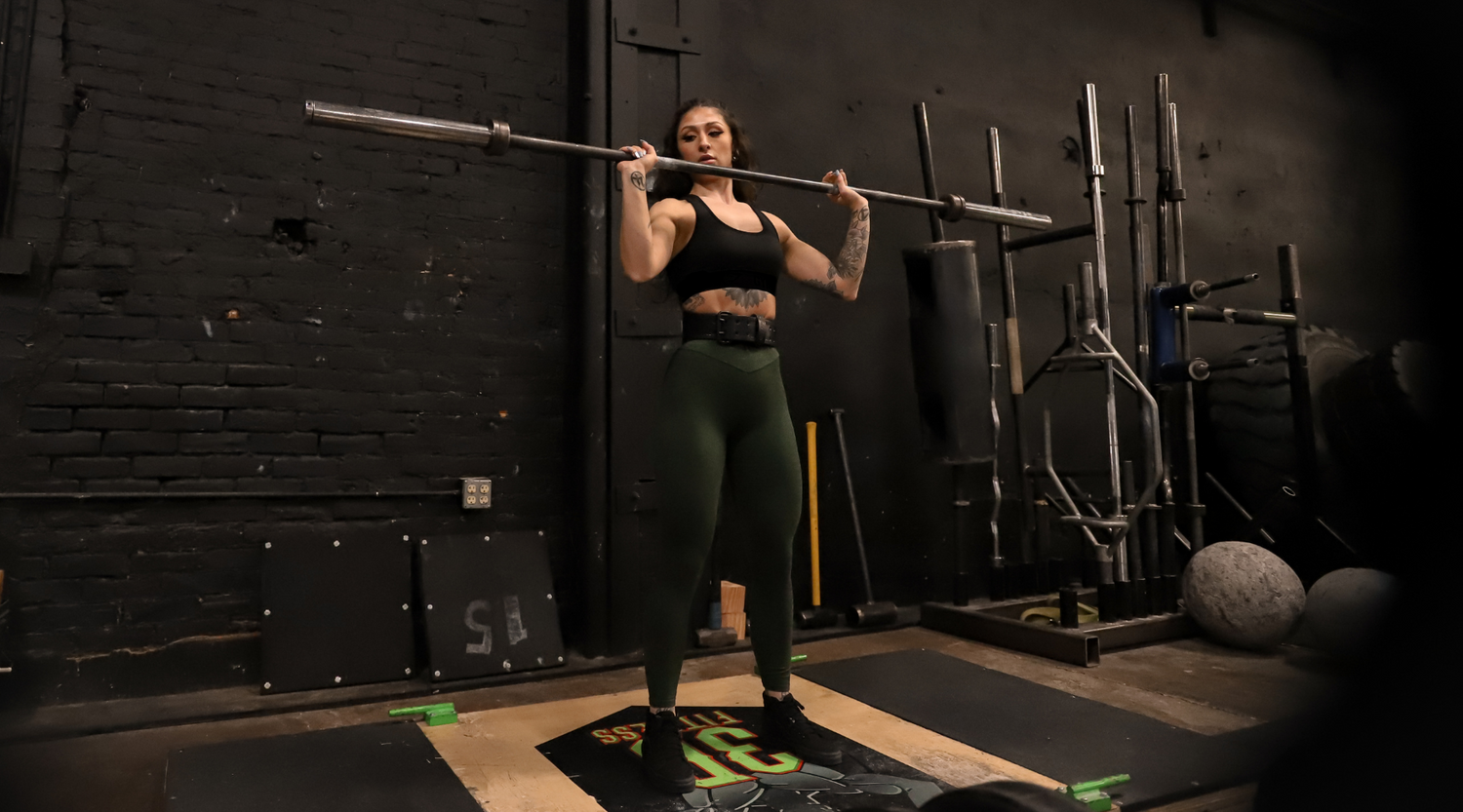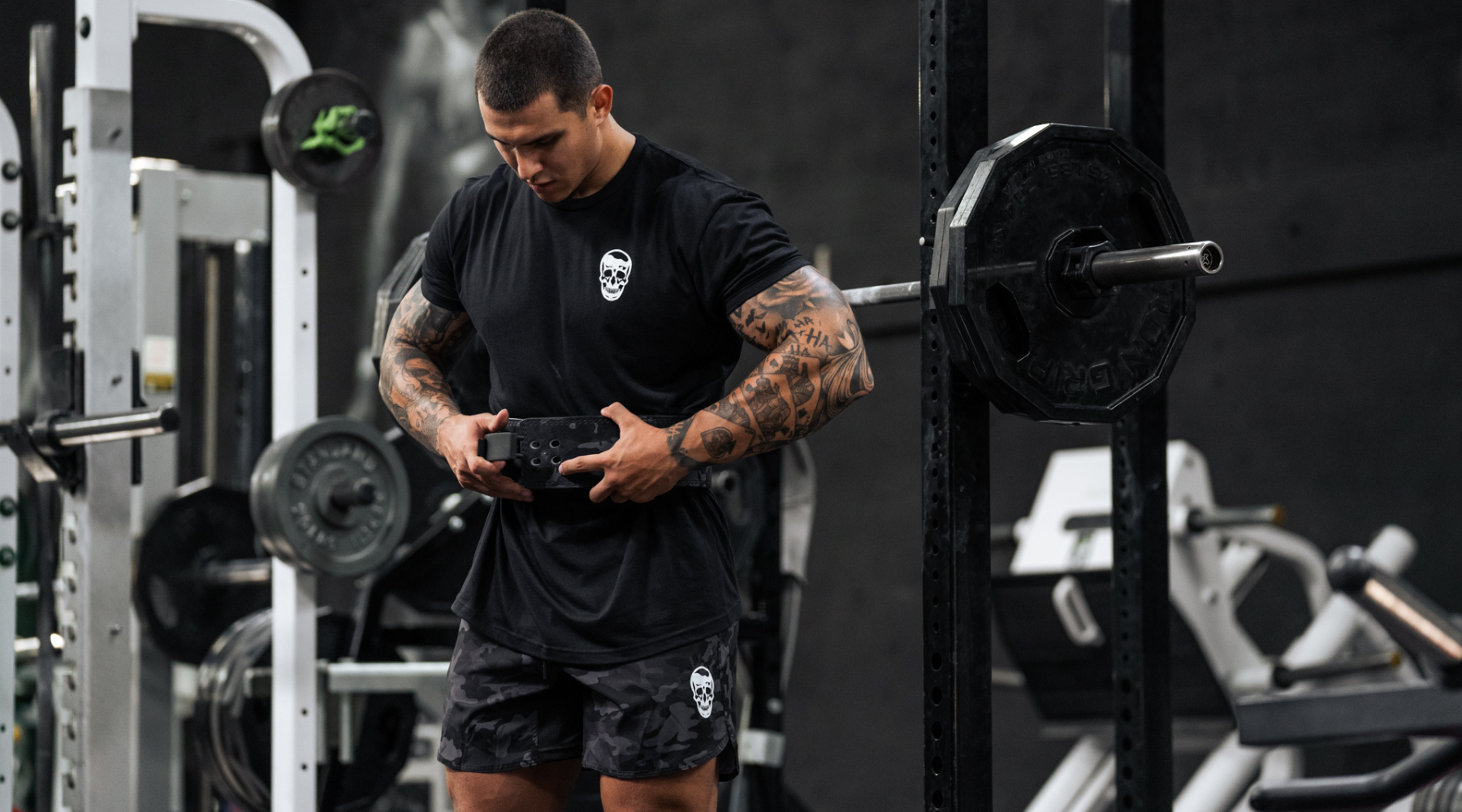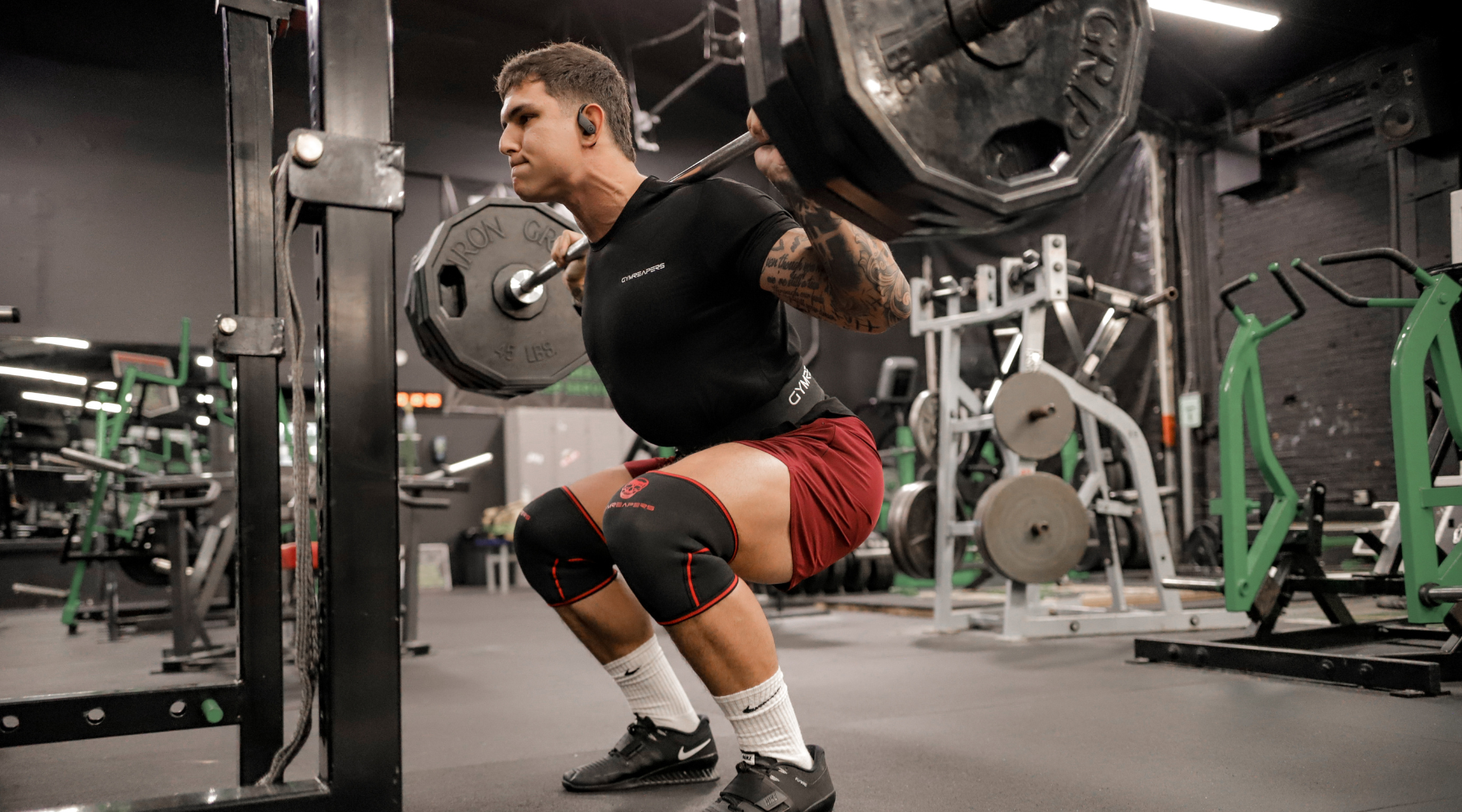While wearing a lifting belt is common for exercises like squats and deadlifts, many lifters are unsure if they should wear one during the overhead press..
Wearing a lifting belt during overhead presses offers you greater support than going beltless, especially around the torso and lumbar spine. Wearing a belt can help you press heavier loads, minimize strain on the lower back, and decrease the likelihood that you hyper-extend your spine.

If you struggle with the overhead press or have tweaked your lower back in the past doing them, you may want to consider wearing a lifting belt (as well as revisiting your technique).
Should You Wear A Belt For Overhead Press
If you already know how to perform overhead presses without a belt, and are looking for a tool to help you lift heavier loads overhead, then consider wear a belt during the overhead press.
It is important to note, however, that wearing a belt does not protect you from injury if you are performing overhead presses with poor form or excessive arching.
Too often lifters will throw on a belt, disregard the form, and assume they are safe.
It is for this reason that beginners and general lifters should opt NOT TO wear a belt during overhead presses until they are fully capable of controlling their torso during the lift.
What does this mean? It should mean that you are not leaning back excessively while trying to press the load overhead. You should keep a relatively stiff spine, with very minimal or no arching in the low or mid back.
If you’ve mastered that technique, then only then can you add a belt to the mix and use it as a tool to enhance your already good form and bracing mechanics (see below).
4 Benefits Of Wearing A Lifting Belt For Overhead Press

Below are four benefits of wearing a lifting belt for the overhead press.
1. Great Stability to Lift Heavier Loads Overhead
A lifting belt helps you increase trunk stability and increase intra-abdominal pressure. Both of these help to provide you with a more stable base.
When training heavy, a stable base is essential, as you minimize any unnecessary movements or instability that could result in lost force output (ability to move heavier loads), movement inefficiency, or injury.
2. Can Help to Prevent Lower Back Injury
Lower back injuries in the overhead press often come from hyper-extending the lumbar spine (lower back). A belt could lower the risk of lower back injury.
When wearing a belt, your lumbar spine is not able to flex as much as without one, simply due to the rigidity of the belt.
Additionally, when paired with proper bracing mechanics, you can increase intra-abdominal pressure (a method for activating your core) and help support the lumbar spine further.
3. Improves Spinal Positioning for Overhead Movements
When performing lifts overhead, you want to ensure you are keeping your pelvis and spine aligned properly to increase force output and minimize injury.
Wearing a belt helps to keep the spine from excessively arching or flexing. In doing so, you are able to maintain your spinal alignment in a stronger (and healthier), vertical position.
4. Reinforces Proper Bracing Mechanics
When wearing a belt during lifts, you are helping your body produce more pressure through bracing. When you wear a tight belt around the waist and inhale, you expand your trunk muscles and diaphragm, increasing intra-abdominal pressure.
While you can do this without a belt (and should know how to), the belt provides you with something to actively push your trunk out against as well as giving you the added rigidity of the belt material (leather or nylon).
Related Articles: Banded Overhead Press and How to Do Push Ups With Bands
4 Reasons Not To Wear A Lifting Belt For Overhead Press

While there are many great reasons to wear a lifting belt for overhead pressing, there are equally many reasons not to wear one.
1. May Disguise Poor Posture
When performing the overhead press, you want to make sure you are not setting the lumbar spine in a hyperextended position (or flexed). Some lifters struggle with this, and their solution is to throw on a belt instead of fixing the actual issue (poor posture).
If you add a belt to an existing poor structure, you will most likely end up getting injured or not getting the full benefit of a lifting belt.
2. Could Become a Crutch
A lifting belt is a tool to help enhance your trunk stability when lifting heavier loads. Some lifters become dependent on wearing a belt, which could be a problem for long-term lifting and applying your pressing abilities to real-life situations.
While some lifters are only concerned with overhead pressing in competitions (where they can wear belts), most lifters are also looking for an improved capacity to lift loads overhead and be strong, both inside and outside of the gym.
Unless you plan on wearing your belt in everyday life, it may be beneficial to learn how to lift without one just as much as it is learning to lift with one on.
3. May Provide You With a False Sense of Security
Too often lifters slap on a lifting belt and assume that they are now invincible, often attempting to lift loads that are outside their safe limits. In doing so, you may be setting yourself up for injury.
A lifting belt is a tool to be used to enhance already good lifting technique and bracing abilities. Many beginners fail to establish those skills, only to then throw on a belt and hope for the best.
If you are not able to produce stability without a belt, learn how to do that first prior to wearing one.
4. May be Difficult to Breath During Higher Rep Sets
If you are performing overhead presses for higher reps, a belt may make it more difficult to get enough oxygen into your body due to the restrictions the belt puts on your breathing cycle.
This of course can vary based on the lifter, but doing higher rep sets of overhead presses can leave you feeling breathless, especially if your belt is worn tightly.
To combat this, you could learn to lift the lighter loads without a belt or wear a looser fitting belt that offers some support but still allows you to breathe during longer-duration sets (such as a nylon vs leather belt).
How To Wear A Lifting Belt For Overhead Press

Below are the keys to properly wearing a lifting belt during the overhead press:
Belt Placement: High vs Low
For most lifters, having the bottom edge of the belt resting above the iliac crest (sides of the hip) will be most optimal for overhead pressing.
This is the most common area and allows you to contract your core muscles and diaphragm to offer truck stability.
Some lifters will wear a belt slightly higher or lower than this based on the movement they are doing, but this is a good rule of thumb to start with.
How Tight Should Your Belt Be?
When performing overhead presses with a belt on, you will want to wear the belt relatively tight if you are performing 1-4 reps.
This will ensure that you have the highest amount of support. You will not need to have too many breathing cycles, therefore a snug fit will be just fine.
If however, you are performing higher rep sets (greater than 5 reps), in which you will need to take many breaths throughout the set, you may want to wear it slightly less tight.
This will allow you to breathe yet still have good support to handle moderate to lighter loads.
You Still Need to Brace
Bracing refers to the act of contracting the muscles of the core to help increase pressure around the torso.
To do this, you need to inhale deeply into your diaphragm (fill the stomach with air) and contract your abdominal muscles.
If you’ve never done this before with a belt, try this simple drill:
How To Practice Bracing Without A Belt
- If you are not sure how to brace, lie down on the floor and place your hands on your stomach.
- Take a deep breath and inhale into the belly, allowing your hands to rise up.
- Next, contract the abdominals and push your lower back into the floor.
- Exhale and repeat.
Once you’ve mastered this drill, you can then apply it during the overhead press.
How To Brace Properly While Overhead Pressing
- With the belt on, deeply inhale and expand your belly right before you unrack the weight.
- Step back, and press the weight overhead. You should not have to take a breath between unracking and your first rep.
- Exhale as the weight is pressed overhead, the lower the weight back down to the shoulders.
- You can either deeply inhale to brace again as the weight is being lowered to the body, or you can reset between reps.
What To Look For In A Lifting Belt For Overhead Press

Chances are you are not looking for a lifting belt that will only be worn for overhead presses.
Belts that are suited for overhead presses can also be worn on other movements like squats, deadlifts, and compound exercises.
Therefore, if you are looking for a rigid belt that can be worn on the main barbell strength lifts, such as the squat, deadlift, bench press, overhead press, and bent over row, then a 10mm leather prong or lever style belt is what you should choose.
A prong belt offers you slightly more versatility if you are planning on wearing the belt higher or lower based on the exercises (a lever belt will need to be adjusted, which can be annoying to do all the time). It also allows you to have some flexibility with how snug you want the belt to be.

A lever-style belt will offer you the highest amount of security, but also lacks versatility and cannot be worn tighter or looser.

If you are looking for a belt to perform overhead presses and dynamic movements, such as snatches, cleans, thrusters, and overhead squats (the Olympic lifts), then you need a more flexible belt.
If you want a flexible belt that provides good stability, a tapered leather belt with a prong attachment would be a good option. The taper allows you to have more mobility for dynamic lifts while still getting rigidity and support from the leather material.

You can also go with a nylon belt that has a ratchet-style fastening mechanism, which will provide you with excellent mobility and a good snug fit. The ratchet fastening system will also give you added belt security to make sure the velcro doesn't come undone under explosive movements.
Articles You May Also Like
If you found this article helpful, take a look at some of these other articles discussing lifting belt styles, pros and cons of each, and how to choose the best one for your needs.
- Exercises You Should and Should NOT Wear a Lifting Belt
- 7 Types of Lifting Belts (Explaining the Pros, Cons, and Which is Best)
- Wearing a Lifting Belt for Squats: Should You Do It?
- Wearing a Lifting Belt for Deadlifts: Should You Do It?
- Wearing a Lifting Belt for Bench Press: Should You Do It?
- Wearing a Lifting Belt for Leg Press: Should You Do It?
- Should You Wear a Lifting Belt for Hip Thrusts? Pros & Cons














Leave a comment
All comments are moderated before being published.
This site is protected by hCaptcha and the hCaptcha Privacy Policy and Terms of Service apply.